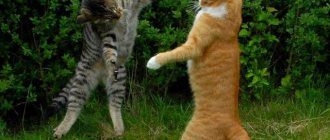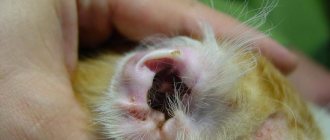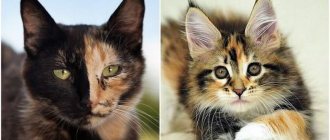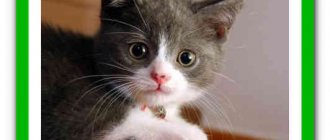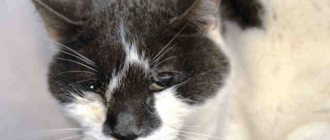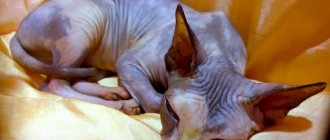4141Pavel
Cats, however, like other pets, are susceptible to many diseases. Timely vaccinations will help avoid some of them. Some of the viruses can be fatal to pets. For example, feline distemper or viral enteritis. At the same time, there is no danger of panleukopenia in cats for humans. No matter how terrible this disease is for a cat, it does not pose any threat to humans.
Having decided to purchase a pet, a person must realistically evaluate that this is not a toy, but a living being, he is now responsible for the health of the cat, and it also needs care.
© shutterstock
Even if the cat is supposed to live indoors, this will not protect it from many diseases. Because viruses can be brought from the street even on the soles of shoes by humans. And this, unfortunately, cannot be avoided in any way.
A disease such as panleukopenia does not pose a threat to the health of the cat owner. But for the animal itself it can be fatal. As a preventative measure, it is necessary to get timely vaccinations. Even if a vaccinated animal gets sick, it will survive the disease in a mild form.
Distemper: what is the disease?
Panleukopenia is an infectious viral disease, which, as mentioned above, develops when the feline panleukopenia virus enters the body. After infection, the number of lymphocyte cells in a pet decreases, and damage occurs to the intestinal walls and lymphatic system.
In most cases, the virus affects kittens and older animals due to a weak immune system. The period when the virus is rampant is spring and summer, when animals reproduce.
Since viral enteritis often causes death, if symptoms of panleukopenia are detected in a cat, treatment should be started immediately by contacting a veterinary clinic.
Consequences of the illness
Plague exhausts the cat. He will need vitamin therapy for at least six months. Necessarily drugs to restore gastrointestinal bacteria. It is important to give bone vitamins to kittens. Often the pet does not return to normal and requires a lifelong diet. It happens that chronic heart failure and central nervous system diseases develop.
From our article you learned the symptoms and treatment of a terrible disease for cats. Keep the number of a veterinary clinic in your phone book to respond urgently and begin treatment. Our recommendations and qualified assistance will allow your pet to become one of the 10% of surviving cats.
Routes of transmission of the virus
The source of this dangerous disease is sick animals or animal carriers. Parvovirus is released into the external environment along with saliva and feces. How is panleukopenia transmitted? Infection can occur in the following ways:
- Oral. The virus will enter the animal's mouth if it drinks water or eats food from the bowl of a sick cat.
- By airborne droplets. Infection occurs if a healthy cat is in close proximity to a sick one.
- By contact. An animal can become infected if it sniffs the personal belongings of an owner who has been in contact with a sick animal or if there is direct contact with a virus carrier.
- In utero. There are no barriers to distemper parvovirus. In addition, it penetrates the placenta. If infection occurs at an early stage, the kittens die in the womb or after birth. If this happened when they were fully formed, then the babies will be born with an underdeveloped cerebellum.
- Transmissible. Such infection is possible through the bite of fleas, bedbugs and ticks.
Almost all members of the cat family can become infected with the virus. It is not as common in wild animals as in domestic animals. Often the disease affects unvaccinated animals before one year or after eight years.
Pregnant cats and small kittens are at risk. Persians, Siamese and Maine Coons have a natural predisposition to the disease.
"Important! Owners of sick animals should not worry; feline panleukopenia is not dangerous to humans.”
General concept
Plague is an acute disease. Its constant companion is severe fever, gastroenteritis, leukopenia, in which the level of white blood cells decreases and bone marrow damage occurs. The animal suffers from rapid dehydration and there is severe intoxication in the body.
The causative agent of the pathology in cats is the virus panleukopenia feline, which belongs to the group of parvoviruses. This pathogen is widespread in nature and is characterized by increased viability.
Panleukopenia is a disease of all felines, in some cases it affects mink and raccoon. It is difficult to treat and has a high mortality rate. At the first symptoms, your pet should be taken to a veterinarian.
Forms of disease development
Distemper in cats can develop in four forms:
- Sub-acute. This course of the disease is typical for pets with strong immunity. The incubation period lasts from one to two weeks. Symptoms in this case will be subtle, and recovery will occur faster than in animals with reduced immunity.
- Spicy. In the acute course of panleukopenia, the disease manifests itself after two days. This form is more common in adult cats.
- Lightning fast. This form is diagnosed in young cats. In kittens, it develops a few hours after pathogenic microorganisms enter the animal’s body. Clinically, this panleukopenia is similar to rabies, but it does not have time to fully develop and the animal dies.
- Chronic. Just a few years ago, veterinarians argued that distemper cannot have a chronic form. However, this theory was recently disproved by blood tests on strays and pets. In some samples, antibodies to panleukopenia parvovirus and the virus itself were detected in small quantities. The chronic course is usually asymptomatic. From time to time, the animal may experience weakness and causeless diarrhea. But if his immune system begins to weaken, the virus will quickly multiply and lead to the sudden death of the pet.
Animals with a subacute form of viral enteritis have a high chance of recovery.
Prevention
Nobivak vaccine
Timely vaccination has the greatest preventive effect. Kittens are vaccinated from eight weeks of age. Immunization is duplicated within two weeks. This happens because the protective system of kittens is imperfect, and the risk of getting sick at this age is high. For a four-month-old kitten, a single immunization is sufficient. The next vaccination is carried out at one year of age. Complex vaccines are in demand - multifel-4 (panleukopenia + rhinotracheitis + calicivirosis + chlamydia) and Nobivak (the same, except chlamydia).
We invite you to join our Zen channel and group on VKontakte or Odnoklassniki, where new articles for pet owners are published.
Similar articles:
- Ringworm Caution: What Pet Owners Need to Know
- Why are cats overweight?
- Nephritis in cats
The first signs of plague
Typically, the virus manifests itself between the second and eighth days from the onset of the disease. If panleukopenia occurs in an acute form, then the symptoms are:
- refusal of food;
- depressed state;
- increase in body temperature up to 40 degrees;
- strong thirst, but the cat drinks very little;
- vomiting with the presence of dark yellow mucous patches;
- the appearance of dark yellow urine;
- drying out of the oral mucosa;
- blueness of the soft palate;
- the appearance of rhinitis, swelling of the larynx and conjunctivitis.
If at least a few signs that characterize distemper occur, the animal should be immediately taken to a doctor to increase its chances of recovery.
Symptoms of panleukopenia
The virus first affects the small intestine, then it enters the bone marrow, lymphatic system, and so, gradually has a damaging effect on all organs in the body. Each form of the disease has its own symptoms. For fulminant distemper, which is typical for kittens up to two weeks of age, the signs are apathy, refusal to eat, plaintive meowing and deterioration in health. Even if you start treating children, in 98% of cases they will die, since the immune system is not able to overcome the disease. In older kittens, hyperacute distemper occurs in the presence of the following signs:
- lethargy;
- lack of response to stimuli;
- dull and matted fur;
- paralysis;
- convulsions;
- bloody vomiting or vomiting with bile.
In kittens from three to seven months old, when this form of the disease develops, the nervous system suffers and the same symptoms appear as with rabies. They are afraid of sounds, hide in dark corners, react aggressively to light, scream and experience nervous overexcitement. A little later, the kitten begins to have diarrhea with a foul odor mixed with blood.
The acute form is diagnosed in adult animals. Its symptoms are as follows:
- apathy;
- high temperature;
- shortness of breath;
- refusal of food;
- yellow, green, or bloody vomit;
- watery stools;
- the appearance of red spots on the skin, which fester and then disappear.
High temperatures do not last long, after which they drop to 37 degrees. A lower temperature indicates that the cat will die soon. The sick animal is thirsty, but strong spasms of the larynx prevent it from drinking. When the virus reaches the heart, shortness of breath begins and heart failure develops. When pathogenic microorganisms enter the lungs, the following symptoms appear:
- nasal discharge;
- redness of the eyes and profuse lacrimation;
- hot and dry nose;
- wheezing and coughing;
- suppuration on the skin.
The subacute form of panleukopenia is considered the most favorable. It is characterized by the main symptoms of plague, but not so pronounced. This development occurs in animals with strong immunity or in cats that have been vaccinated.
Panleukopenia in cats symptoms
Symptoms appear 2-12 days after infection.
- Vomit
- Diarrhea
- Weakness
- Temperature rises to 40-41 degrees
- As the disease progresses, blood appears in the vomit and stool
- Lack of appetite
- The cat sits hunched over a bowl of water, but does not drink
- The animal tries to hide in a dark corner
- The fur loses its shine, becomes unkempt, and sticks out in different directions.
- Kittens often have damage to the nervous system: the animal becomes restless and very timid
- The animal may experience paralysis of the limbs; in this case, without assistance, death may occur within 24 hours
- Damage to the respiratory system is possible, inflammatory processes occur in the lungs
- The mucous membranes become covered with ulcers and pus.
- The animal is severely dehydrated
- Due to oxygen starvation, intoxication and dehydration, the mucous membranes of the mouth become pale and bluish
Diagnosis of viral enteritis
Only a veterinarian can understand whether a cat is suffering from distemper or is developing a completely different illness. To do this, you need to take the animal to the clinic, taking with you the vaccination passport and pet card. First, a specialist will examine the animal, and then tests for panleukopenia will be performed.
A sample of the animal's stool will be taken using the PRC method. This study will help find particles of a dangerous virus in it. Blood will also be drawn. If the doctor finds a decrease in the leukocyte level in the test results, then the disease is confirmed.
A similar set of differential diagnostic measures is necessary in order to really make sure that an animal has distemper, because its symptoms are similar to leukemia, immunodeficiency, poisoning and intestinal perforation. Only by drawing up a complete clinical picture can the diagnosis be confirmed or refuted.
Treatment of plague
Clinical therapy for the disease is most effective, since it combines a full range of measures aimed at relieving the disease. It will be impossible to cure a cat at home.
How to treat panleukopenia? In each case, treatment is selected individually, taking into account the form of the disease and the general condition of the furry patient. However, there is an average therapeutic regimen that most clinics use. All of the drugs described below will need to be administered once a day:
- the drug “Forvet” is administered to the animal subcutaneously in a dose of 0.5 milliliters;
- vitamin B6 is administered intravenously in a dose of 0.5 milliliters along with the same dosage of vitamin B12;
- The cat is given 1 milliliter of Riboxin and vitamin C by intravenous infusion;
- Sinulox is administered subcutaneously at a dose of 0.2 milliliters;
- Metrogyl is administered intravenously at a dose of 2 milliliters;
- sodium chloride is dripped intravenously in a dose of 80 milliliters;
- glucose 5% is administered subcutaneously in a dose of 20 milliliters.
Antibiotics of the cephalosporin group are injected as prescribed by the veterinarian. The animal is also administered the drug “Filgrastim” to accelerate the production and release of neutrophils and other cells of the leukocyte group into the bloodstream.
About the parvovirus
DNA parvovirus causing panleukopenia is not new. It has especially spread since the 70s of the last century, when breeding cats and developing new breeds became popular. Not only domestic pets are susceptible to the virus, but also their wild relatives - tigers, lions, leopards, etc., as well as representatives of the mustelid family - ferrets, minks. A very similar disease occurs in dogs; its causative agent is canine parvovirus.
Parvovirus is a tough, persistent virus. It “sticks” to any surface, is resistant to high temperatures and many disinfectants (at home, if there are no special preparations, the most effective means of destroying the virus is household bleach). But even the most thorough treatment does not guarantee complete destruction of the virus. Therefore, you should not bring a new animal into the room where the sick cat was located earlier than a year later.
Once in the animal’s body, the virus multiplies in the lymphoid tissue of the cat’s throat (thymus and spleen). It then spreads throughout the cat's body, attacking and destroying cells that are dividing rapidly. First of all, these are the cells of the bone marrow and the tissue lining the intestines. Therefore, the effect of parvovirus resembles radiation sickness (leukemia) or poisoning. And owners often initially assume that the pet “ate something wrong.”
Sick animal menu
The disease panleukopenia in cats is very difficult for animals to tolerate, and in order to maintain strength during therapy and help the pet recover faster, its diet should be carefully selected.
After the cat's appetite begins to return, it should be fed light, pureed and warm food. You shouldn’t force food on your pet when the time comes for him to eat on his own.
Portions should be small. A sick cat should be fed six times a day. From food you can give low-fat broth, yogurt, kefir and cottage cheese. After three days, in order for the cat to recover faster from panleukopenia, a small amount of boiled fish and lean beef should be introduced into the diet.
Cereals, vegetables and raw food are contraindicated for the animal; it can be introduced little by little only when two months have passed after complete recovery.
Establishing diagnosis
If your cat shows signs of panleukopenia, you should immediately measure its temperature. Normally, this indicator is in the range of 38–39 °C. If it is elevated, you need to immediately take the cat to the veterinarian. The doctor will conduct an examination and prescribe tests to confirm or refute the diagnosis:
- Clinical blood test. With panleukopenia, the number of leukocytes and red blood cells is always reduced in the cat’s blood.
- Nasal swab.
- Stool analysis.
To successfully treat feline panleukopenia, it is very important to differentiate it from other diseases that have similar symptoms. It is necessary to exclude pancreatitis, feline leukemia, poisoning, damage to the gastrointestinal tract by foreign bodies, acute toxoplasmosis and feline immunodeficiency virus.
Complications after plague
If the symptoms of panleukopenia in a cat were noticed on time and treatment was started immediately, the animal will quickly gain weight, restore all indicators and return to its normal life.
However, panleukopenia in cats does not always go away without a trace. Sometimes its consequences remain for the rest of your life. These include chronic changes in the cardiovascular, respiratory and nervous systems. To stop these problems, the animal is prescribed supportive therapeutic courses and a special diet for the rest of its life.
Consequences and life expectancy of a cat
If symptoms of distemper in a cat are detected on time, then the negative consequences for the animal are minimized. Over time, body functions will be restored, and the pet will live a normal life. After the cat has overcome distemper, its body will produce antibodies to this disease and the likelihood of illness will be reduced to a minimum. Timely diagnosis of the disease has a positive effect on life expectancy.
If the form of the disease is fulminant, and it is not possible to diagnose the disease in time, the consequences for the animal can be severe. Often, animals that have had severe enteritis experience heart and pulmonary failure and problems with digesting food. The consequences oblige the owner to put the cat on a diet and monitor its nutrition and weight throughout its life. Restrictions will help your pet live a long, quality life.
Is the disease dangerous for humans?
Viral enteritis is only dangerous for cats. A person can be a carrier of this disease, but he himself does not become infected.
Disinfection of the animal's place of residence
Everyone knows that panleukopenia in cats is dangerous, so in order to avoid re-infection after recovery and not infect other animals, if any, you must carefully follow the recommendations for disinfecting premises:
- treat the room with the sick animal daily with sodium hypochlorite solution and a UV lamp;
- treat the bed, toys and food bowl with a solution of soda and formaldehyde gas;
- several times a day, do wet cleaning in the room with a sick animal and ventilate the room;
- quickly remove cat feces and vomit;
- make sure that there is shade in the room and that the sun does not fall on the sick pet;
- constantly drip the drops prescribed by the doctor and wipe the animal’s eyes with a cotton swab dipped in chamomile infusion.
By performing these procedures, you can minimize the risk of re-infection with distemper in other animals (if any) and the sick pet after recovery.
Caring for a cat when sick
Proper care of a sick animal promotes a speedy recovery:
- The cat must be surrounded with love and care.
- The pet should be placed in a warm, dry, dark, but regularly ventilated place.
- Every 2 days it is recommended to disinfect your pet’s sleeping place.
- Do not force feed or water your pet. This will only worsen the course of the disease.
- It is better to give your cat only warm boiled water to drink.
- All animal feces must be removed immediately and the tray treated with disinfectants.
- The pet's eyes, nose and face should be regularly cleaned of accumulated dirt.
- The premises need to be regularly wet cleaned.
- It is strictly forbidden to let your pet go outside.
- It is important to stick to your treatment plan. You cannot use folk remedies and alcohol without permission.
- In the first days after starting treatment, it is recommended to feed your pet dairy products and meat broths. Then introduce carefully chopped boiled beef and deboned sea fish into the diet. A similar diet should be followed for 3-4 weeks. If the animal eats ready-made food, during the treatment period it is necessary to switch it to special food for cats with digestive problems.
Preventive actions
To minimize the possibility of your furry pet becoming infected with distemper, you should follow preventive measures:
- if there are several cats in the house and one of them is sick, the second healthy animal should be given to friends for the duration of treatment to prevent infection;
- If a healthy animal does not develop the disease after three weeks of the incubation period, it must be vaccinated. The vaccine against panleukopenia will be selected by the veterinarian after examining the animal;
- The distemper vaccination should be given when the kitten is two months old, and after three weeks it should be revaccinated. Even if the animal gets sick, it will quickly recover, since panleukopenia in vaccinated cats is easy and does not lead to death;
- adult animals should be vaccinated annually. However, pregnancy is a contraindication to vaccination; this must be taken into account so as not to harm the pet.
Today, there are serums that contribute to the formation of intense immunity against the disease that persists throughout the year. Only healthy animals that have been treated against helminths and fleas can be vaccinated. Vaccination is recommended with Multifel, Novibak, Quadricat or Felotel.

